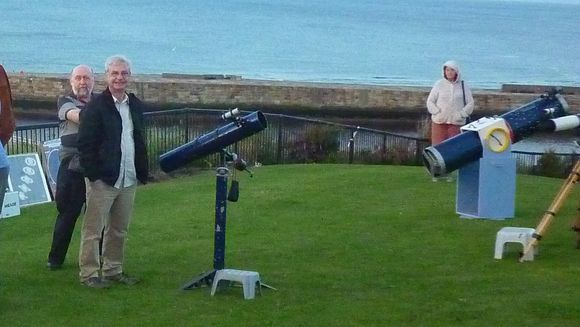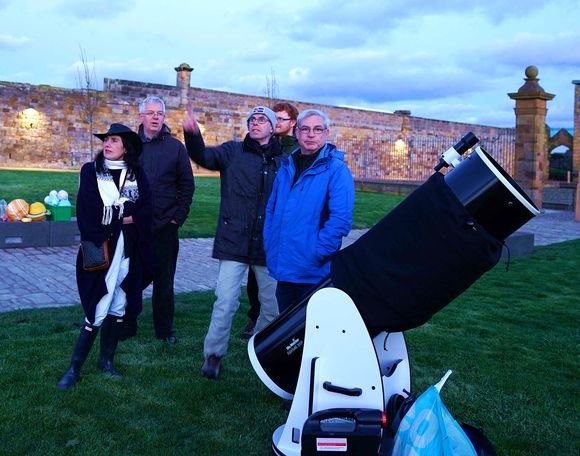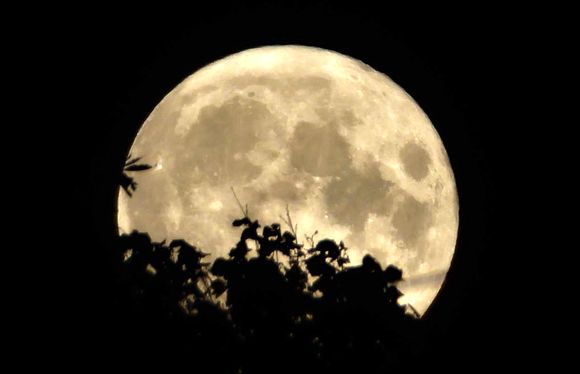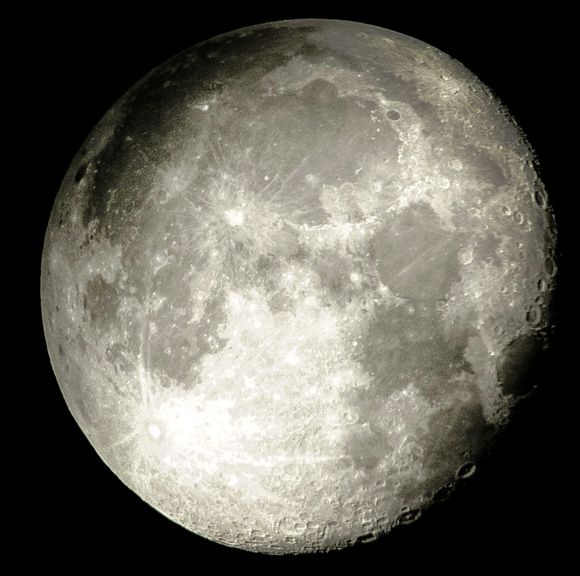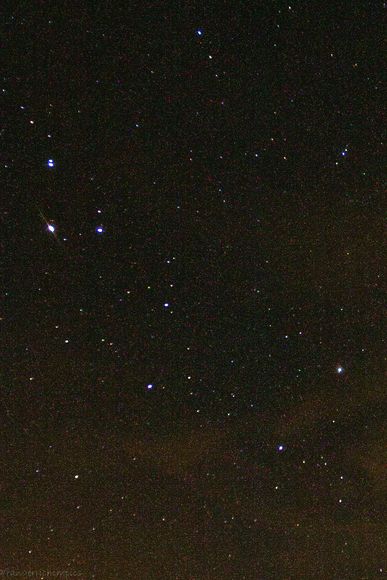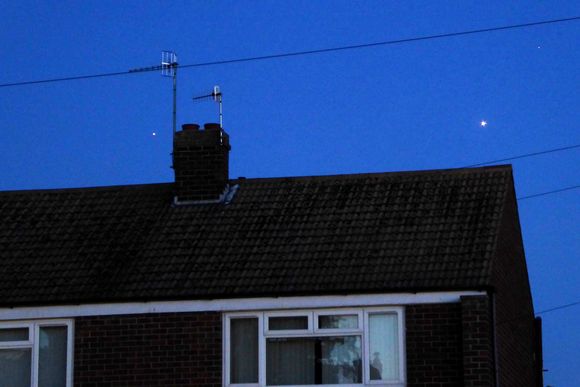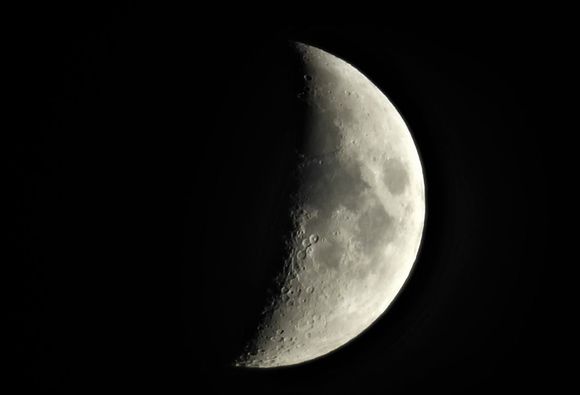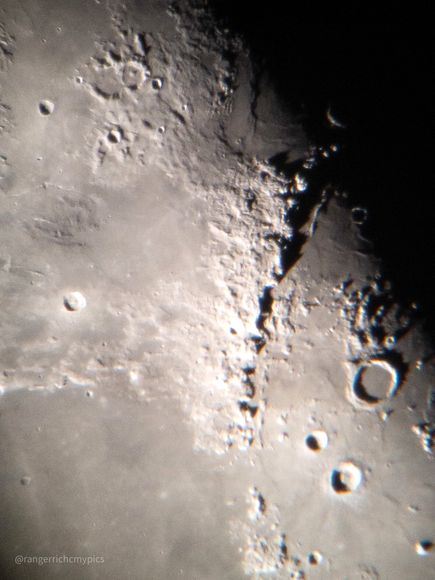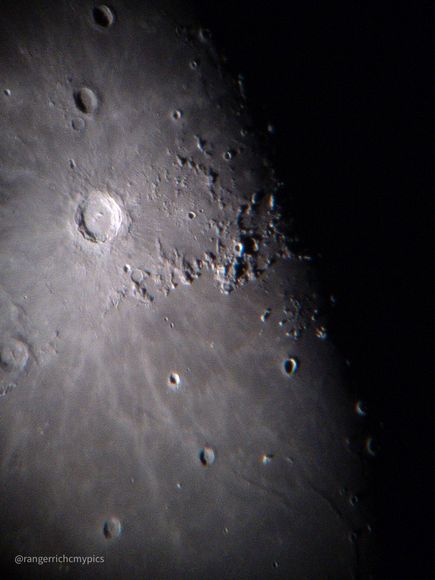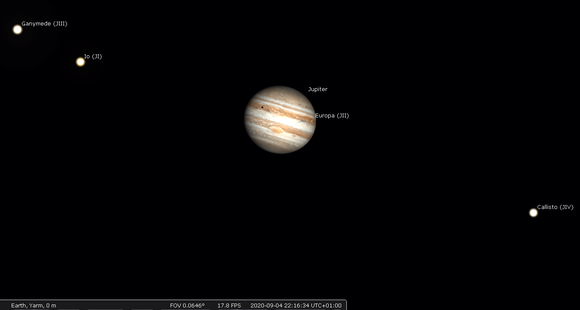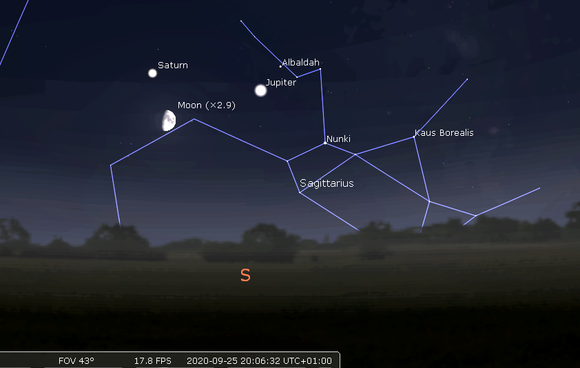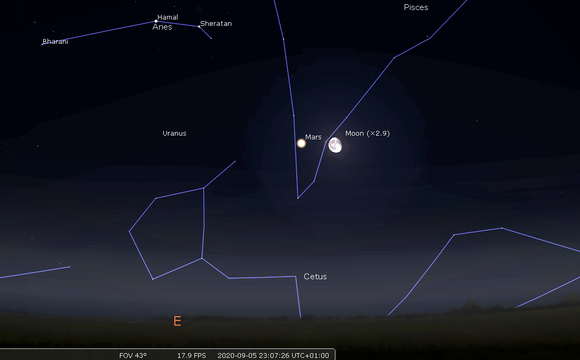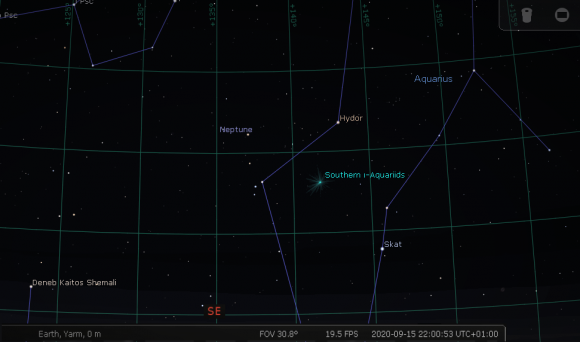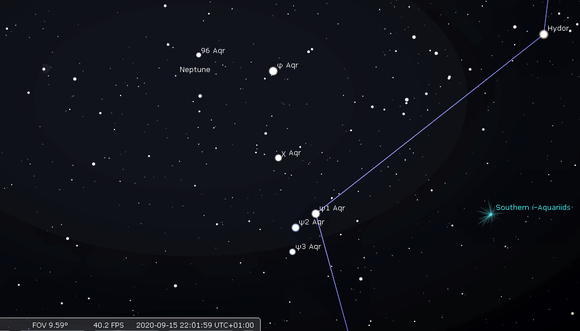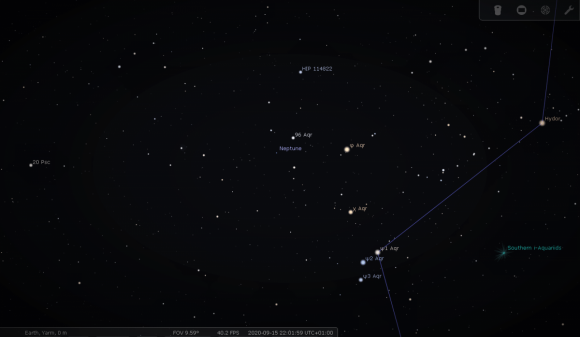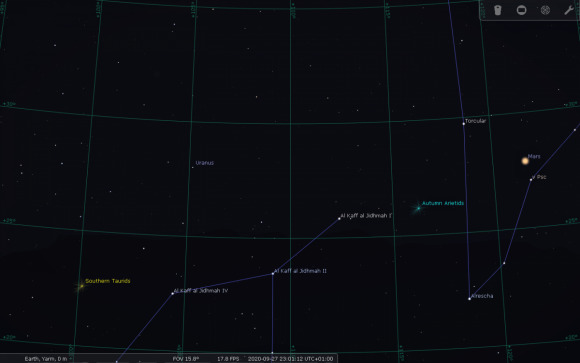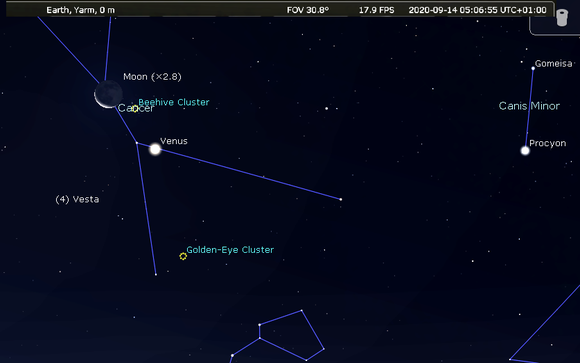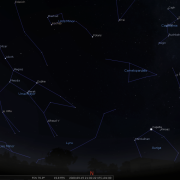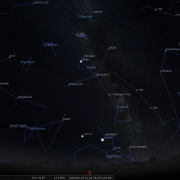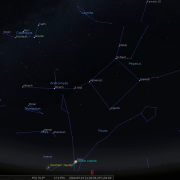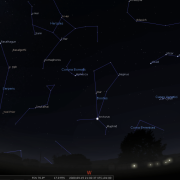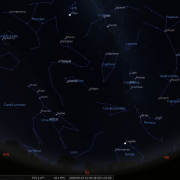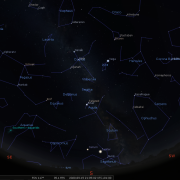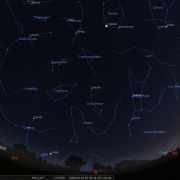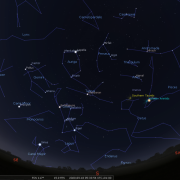Welcome to the WDAS monthly newsletter for September 2020: a digest of the month's latest contributions to our website. Below you'll find Society News: including Member photos, a fare-ye well to one of our good friends and longest standest Members, as he heads for the hills in search of pastures new, across the distant Northern border. And Sky Notes for the coming month. Obviously. ;-)
Society News
No.
Cancelled earlier in the year, a casualty to the Covid 19 pandemic, this year’s Whitby Regatta (had it gone ahead) would still have been a huge disappointment weather-wise with cloudy, misty and damp conditions prevailing across the weekend. I very much doubt whether we would have even ventured onto the West Cliff at all, such were the leaden skies. Some things never change.
With certain parts of the UK basking in a heat wave, clear skies were in short supply, certainly round here. Predictably, little was seen of the Perseids, comet NEOWISE is but a memory, and even the few star party events tentatively planned in early August, would all have been cancelled due to the weather.
Hook's House Event - 22nd August 2020
Planned as our first real outdoor ...outreach event, it was hoped conditions would play ball for our annual pilgrimage over to Hook’s house. They did, unfortunately it was after 23:00h, long after the event had been cancelled by Mark due to forecast rain – which did arrive for the several hours we would have been present on the campsite. Lady luck has deserted us in August – with no star parties possible due to the ‘bad weather pandemic’!
Westerdale Event
As of ‘going to keyboard’, we haven’t yet officially had a date confirmed for the annual Westerdale star party event, but it certainly will not be in September. Hopefully however, we are looking to host one on either Oct 9th or 10th. We shall seek conformation in time for October’s notes.
Monthly Meetings Recommence??
WDAS monthly meetings may also possibly re- start in October, but to be honest we won’t know whether it will be feasible until after the college goes back and settled down... or not. We may get to know by late September. If it is October, It may also not be the first Tuesday of the month (Oct 1st), but rather later on in the month... should we be given the go ahead. It’s a case of watch this space.
We will soon sadly be losing one of the stalwarts of the society shortly: Andy Lawrence. I say sadly, but for Andy and his wife, Anne, it is the start of a whole new exciting chapter in their lives as they move up to Scotland by October.
Andy has been a valued member for over 20 years (and hopefully will continue to be so). He just won’t be physically present at our star parties, meetings or astro-days out. His enthusiasm and willingness to assist over all this time, in all weathers and locations, will really be a sore loss and his participation will be greatly missed. But hopefully he will be taking many treasured memories of society events north of the border.
I feel sure I speak for all our members in wishing Andy and Anne all the very best for their new life in retirement in Scotland. Here’s to you Andy!!
Thanks to Members for some stunning pictures of The Moon, Jupiter, and the house across the street.
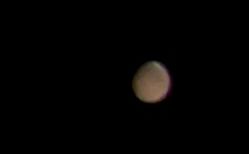
07-Aug-2020 at 05:45h:
Mars, by Richard Randle.
11-Aug-2020 at 23:30h: Alcor and Mizar, by Richard Randle
(in France). (Click for full-sized image.)
26-Aug-2020 at 21:30h: The Moon: Appennines with Archimedies lower right.
By Richard Randle. (Click for full-sized image.)
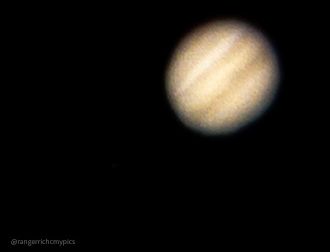
26-Aug-2020 at 22:00h: Jupiter, by Richard Randle.
28-Aug-2020 at 22:15h: Crater Copernicus, upper left,
by Richard Randle. (Click for full-sized image.)
Sky Notes
In this month's Sky Notes:
Planetary Skylights
Jupiter and Saturn are better placed for ‘observer friendly’ observations throughout September, however by the end of the month Jupiter’s crown as dominant evening planet will be usurped by Mars. Neptune comes to opposition this month, whilst Venus reigns supreme in the dawn sky.

As twilight falls you will locate conspicuous Jupiter to the south, with Saturn following a little distance in its wake. Although both came to opposition a few months ago, they will now be more favourably placed for observation during the evening to the left of the ‘teapot’ asterism in Sagittarius.
Both are very rewarding to view with smaller instruments, even binoculars are sufficient to reveal the Galilean moons of Jupiter, but not quite the rings of Saturn, you will require a small telescope at least to view them.
Over the course of September Jupiter will fade a tad from Mag -2.4 to -2.2. Apertures of 100mm (4inch) or above is sufficient to reveal some detail on the banding across Jupiter’s flattened disk, and when orientated towards us the great red spot (GRS), the major storm feature on Jupiter. By Septembers end Jupiter will be setting by 23:30 BST.
Jupiter GRS and Galilean moon shadow transit visibility- evenings only. All times BST.
- 1st GRS visible and Io shad transit from 22:00h.
- 2nd GRS visible 20:30–21:30h.
- 3rd GRS visible from 23:30h.
- 4th GRS 20:30–23:00h. Europa shadow transit from 22:00h.
- 6th GRS visible from 21:00h.
- 8th GRS visible from 23:00h.
- 9th GRS visible from 20:00h to 22:00h.
- 10th Io shadow transit 20:00–21:00h.
- 11th GRS visible from 21:45h.
- 12th Ganymede shadow transit 20:00–22:30h.
- 13th GRS visible from 22:00h.
- 14th GRS visible 19:35–22:15h.
- 16th GRS visible 21:00–22:45h.
- 17th Io shadow transit 20:00–22:00h.
- 18th GRS visible from 21:15h.
- 19th GRS visible 19:45–20:45h.
- 21st GRS visible 20:00–22:00h.
- 23rd GRS visible 20:00–23:00h.
- 24th Io shadow transit from 22:15h.
- 25th GRS visible from 22:15h.
- 26th GRS visible 19:30–21:15h.
- 28th GRS visible 20:00–23:00h.
- 29th Europa Shadow transit 19:30–21:00h.
- 30th GRS visible from 21:00h.
Stick with it, as moments of clarity will reward your patience. The Moon passes below Jupiter and Saturn on the 1st and 2nd respectively and again on the 28th and 29th.
04-Sep-2020 at 22:15h (S): Jupiter with (L to R) Ganymede, Io, Europa's shadow and Calisto.
(Click for full-sized image)
 Saturn is also now best placed during the evening. At mag +0.4 it appears considerably fainter than Jupiter, but is still quite prominent to the eye. The rings remain well orientated with respect to earth, and given moments of good seeing the two main rings; A and B should be evident, separated by the Cassini ‘gap.
Saturn is also now best placed during the evening. At mag +0.4 it appears considerably fainter than Jupiter, but is still quite prominent to the eye. The rings remain well orientated with respect to earth, and given moments of good seeing the two main rings; A and B should be evident, separated by the Cassini ‘gap.
Look also for Titan, Saturn’s largest moon, which resembles a bright, but obvious speck nearby Saturn.
 Have patience at the eyepiece when viewing Jupiter and Saturn as neither are particularly high above the horizon, with ‘seeing’ thru’ the eyepiece compromised somewhat by the turbulent air. The Moon passes below Jupiter and Saturn on the 24th and 25th respectively.
Have patience at the eyepiece when viewing Jupiter and Saturn as neither are particularly high above the horizon, with ‘seeing’ thru’ the eyepiece compromised somewhat by the turbulent air. The Moon passes below Jupiter and Saturn on the 24th and 25th respectively.
 Mars is already conspicuous to the naked eye in the early morning sky, but rapidly gains in brightness through September as it heads towards opposition in October and by the end of the month will become the dominant presence in the late evening sky. Look for the distinct orange hue of the planet rising in the east when Jupiter and Saturn lie to the south. By September 9th Mars reaches its first stationary point, before starting to move in retrograde motion (east to west) through Pisces. By the end of September the red planet will have increased in brightness to -2.5, from Magnitude -1.8 at the start.
Mars is already conspicuous to the naked eye in the early morning sky, but rapidly gains in brightness through September as it heads towards opposition in October and by the end of the month will become the dominant presence in the late evening sky. Look for the distinct orange hue of the planet rising in the east when Jupiter and Saturn lie to the south. By September 9th Mars reaches its first stationary point, before starting to move in retrograde motion (east to west) through Pisces. By the end of September the red planet will have increased in brightness to -2.5, from Magnitude -1.8 at the start.
Telescopically Mars is improving through the eyepiece, with the disk size approaching 22.5 arc seconds by the end of the month. This is still however half the size of Jupiter’s disk, so do not expect to view something as ‘big as a pizza’ despite what some reports on the ‘net may imply. If there are no obscuring Martian dust storms, you will be gazing at the surface itself; apart from our moon, Mars is the only other body in the solar system where the surface is visible to typical amateur instruments. Features to look out for are the southern polar cap, Syrtis Major and Hellas Planitia. The waning moon passes below Mars on the 5th.
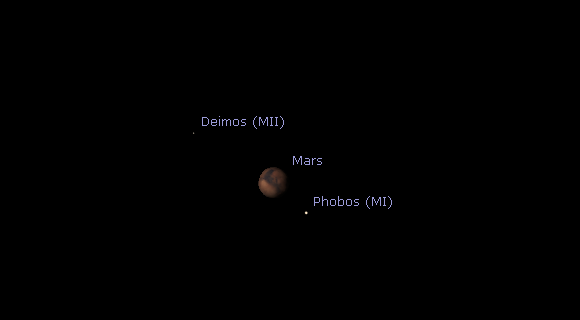
01-Sep-2020: Mars with moons Deimos and Phobos.
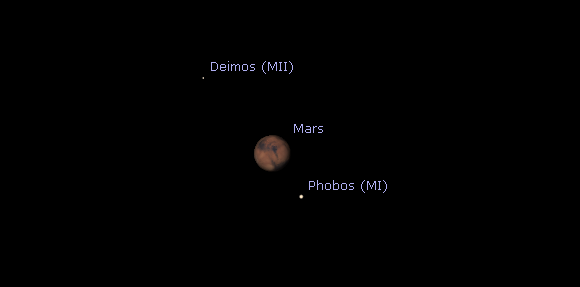
30-Sep-2020: Mars with moons Deimos and Phobos.
 Neptune reaches opposition on the 11th and resides in the constellation of Aquarius. On opposition night Neptune lies just over 2 degrees north-east of the star Phi aqr (Mag +4.2), whilst 96 aqr. (Mag +5.5) lies 42 arc minutes to the WNW of it. At a distance of 4.3m km (2.67m miles), you will require a telescope to spot the diminutive disk, which has a blue/grey hue. Binoculars will also show it as a speck – if you know exactly where to look. A 10” scope or larger should be able to pick out Triton, Neptune’s largest moon.
Neptune reaches opposition on the 11th and resides in the constellation of Aquarius. On opposition night Neptune lies just over 2 degrees north-east of the star Phi aqr (Mag +4.2), whilst 96 aqr. (Mag +5.5) lies 42 arc minutes to the WNW of it. At a distance of 4.3m km (2.67m miles), you will require a telescope to spot the diminutive disk, which has a blue/grey hue. Binoculars will also show it as a speck – if you know exactly where to look. A 10” scope or larger should be able to pick out Triton, Neptune’s largest moon.
27-Sep-2020 at 23:00h (SE): Uranus finder chart in Aries: some way to the left of Mars.
(Click for full-sized image)
 Uranus resides in the southern reaches of Aries, and is best observed later in the night when higher to the south, but you will find it above the east horizon at 22:00h forming a triangle with Torcular in Pisces and Al Kaff al Jidmah I in Cetus. At Mag +5.7 Uranus is a borderline naked eye object from dark sites, but realistically binoculars or a telescope are required to positively identify it. The disk of Uranus exhibits a ghoulish grey/green sheen. Uranus comes to opposition next month.
Uranus resides in the southern reaches of Aries, and is best observed later in the night when higher to the south, but you will find it above the east horizon at 22:00h forming a triangle with Torcular in Pisces and Al Kaff al Jidmah I in Cetus. At Mag +5.7 Uranus is a borderline naked eye object from dark sites, but realistically binoculars or a telescope are required to positively identify it. The disk of Uranus exhibits a ghoulish grey/green sheen. Uranus comes to opposition next month.
 If you are an early riser look for brilliant Venus quite high in the eastern dawn sky, at Mag - 4.2 it can hardly be missed! Venus actually rises shortly after 02:00h and will still be evident even as skies lighten. On the morning of the 14th Venus resides below the open star cluster known as the ‘Beehive’ or M44, in Cancer, with a very slim moon visible above the cluster. The vista should make for a fine sight in binoculars. A telescope will reveal the 60% phase spanning some 20 arc seconds.
If you are an early riser look for brilliant Venus quite high in the eastern dawn sky, at Mag - 4.2 it can hardly be missed! Venus actually rises shortly after 02:00h and will still be evident even as skies lighten. On the morning of the 14th Venus resides below the open star cluster known as the ‘Beehive’ or M44, in Cancer, with a very slim moon visible above the cluster. The vista should make for a fine sight in binoculars. A telescope will reveal the 60% phase spanning some 20 arc seconds.
Meteors

None mentioned, this month.
Autumnal Equinox
By astronomical convention autumn officially commences in the northern hemisphere on the date of the Autumnal Equinox, when from our perspective the Sun re-crosses the celestial equator and heads south, arcing ever lower above the south horizon. This year the date of the equinox falls on September 22nd.
For the second time in its orbit around the Sun, neither of Earths poles is inclined towards our nearest star with hours of daylight and darkness almost equal across the whole planet. As the northern hemisphere continues to tilt away from the Sun, evenings will rapidly draw in once again as we head toward winter. Cheery thought!
September 2020 Sky Charts
Additional Image Credits:
- Planets and Comets where not otherwise mentioned: NASA
- Sky Charts: Stellarium Software
Events
 Observe the night sky with us at the Bruce Observatory, Whitby School
Observe the night sky with us at the Bruce Observatory, Whitby School
Observing Nights are held weather permitting: check for a relatively clear sky before leaving home. If in doubt, Mark can be reached on 07886069339
Please note the college drive gate is now operated via a electronic key code - so anyone wishing to attend must be at the car park at the top of the drive by 19:00hrs - unless an arrival time has been arranged with Mark/Keith.
 Whitby School - Room H1.
Whitby School - Room H1.
In Members' monthly meetings we usually take a tour of the night sky for the coming month using the Planetarium program. Have talks and presentations on various topics of astronomy/space etc, and discuss future events etc. New members welcome.

